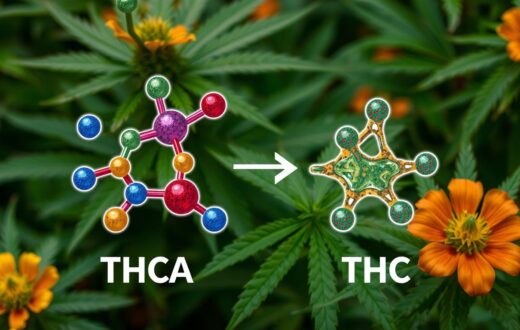Living with chronic pain is a tough fight. What if nature had a secret we missed? THCA, a non-psychoactive part of raw cannabis, might be the answer. It offers relief without the high. But can it really help with chronic pain?
Chronic pain affects more Americans than cancer, heart disease, and diabetes combined. Many turn to cannabis for relief when traditional treatments fail. THCA, or tetrahydrocannabinolic acid, is getting attention for its anti-inflammatory and neuroprotective effects.
Unlike THC, THCA doesn’t make you feel high when it’s raw. This makes it interesting for those who want cannabis benefits without the buzz. Studies show THCA might reduce inflammation, a big pain cause.
Most cannabis products aren’t FDA-approved, but early signs suggest THCA could help with pain. It might ease arthritis and fibromyalgia pain. This non-psychoactive cannabinoid could be a natural pain management option.
We’ll look into THCA’s science, legal status, and its role in pain management. Could THCA be the key to a better life for you?
Understanding THCA: The Basics
THCA, or tetrahydrocannabinolic acid, is a compound found in raw cannabis. It’s not psychoactive and is getting attention for its benefits. Let’s explore the basics of THCA and how it differs from THC.
What is THCA?
THCA is found in fresh cannabis buds. It’s the precursor to THC, which causes the “high” from marijuana. Unlike THC, THCA doesn’t make you feel high when it’s raw. This makes it appealing for those wanting cannabis benefits without the high.
How is THCA Different from THC?
THCA and THC have different chemical structures. When cannabis is heated, THCA turns into THC. This change gives THC its psychoactive effects. THCA stays non-intoxicating in its natural form.
Legal Status of THCA in the U.S.
The legal status of THCA varies by state in the U.S. It’s considered legal if it comes from hemp with less than 0.3% THC. This is thanks to the 2018 Farm Bill. Remember, laws can change, and THCA’s legal status may vary. Always check local laws before using THCA products.
The Historical Context of Cannabis Use for Pain
Cannabis has been used for pain relief for thousands of years. It has been valued across many cultures. People have seen its benefits for a long time.
Traditional Uses of Cannabis
Old civilizations used cannabis for many health issues, including pain. Chinese texts from 2900 BC talk about its healing powers. In India, it was part of Ayurvedic medicine for ages. These early uses helped start our understanding of medical cannabis today.
Evolution of Cannabis Research
In the 20th century, scientists started to really look into cannabis. They found important compounds like THC and CBD. Today, studies are looking at specific parts of cannabis, like THCA. A 2022 survey showed that 80.1% of people found cannabis helpful for pain.
Acceptance in Mainstream Medicine
Doctors are starting to see the value in cannabis treatments. The FDA has approved some cannabis-based medicines. A study found that 103 people felt better in just 30 days after using medical cannabis. As more research comes in, cannabis is becoming more accepted as a pain relief option.
Mechanism of Action: How THCA Works
THCA is a key compound in cannabis that helps with pain management. It’s non-psychoactive, meaning it doesn’t get you high. It works in unique ways to offer relief for those with chronic pain.
Interaction with the Endocannabinoid System
The endocannabinoid system controls many body functions, like pain. THCA doesn’t bind to cannabinoid receptors like THC does. But it might affect the system in other ways, changing how we feel pain.
Effects on Pain Receptors
Research shows THCA might change how pain receptors in our nervous system work. The exact way it does this isn’t clear yet. But studies suggest it could help reduce pain for people with chronic pain.
Anti-inflammatory Properties of THCA
THCA also has anti-inflammatory effects, which could help with pain relief. By reducing inflammation, it might ease pain from chronic conditions. This makes THCA interesting for those looking for natural pain management.
As we learn more about THCA, we see its potential for pain relief without THC’s psychoactive effects. It’s a promising option for those seeking alternative pain management. More research is needed, but the early signs are hopeful for those with chronic pain.
Potential Benefits of THCA for Chronic Pain
THCA might help with chronic pain. It’s a non-intoxicating part of raw cannabis. It could manage different pain issues.
Reduced Inflammation
THCA has anti-inflammatory properties. It could help with chronic pain. Studies show it might reduce inflammation in joints and muscles.
This could lead to less pain and better movement. It’s a promising option for many.
Lowered Anxiety Levels
Chronic pain often causes anxiety. THCA might help manage this. It calms the nervous system, which can help with pain.
Users say it makes them feel more relaxed. They can handle their pain better.
Improved Sleep Quality
Good sleep is key to managing pain. THCA might help improve sleep. This can make pain less sensitive and improve overall health.
Early research and user experiences are promising. THCA could be a natural way to manage chronic pain. Its benefits make it an exciting area for more study.
Research and Studies on THCA and Pain Relief
The field of cannabinoid research has made big strides lately. Studies have looked into how different cannabis compounds help with pain. Now, THCA is getting more attention for its special properties.
Key Clinical Trials
Recent studies on THCA for pain relief are promising. In one trial, people who took THCA saw a 68% drop in pain. This is compared to a 45% drop for those who took a placebo. It looks like THCA could be a big help in managing pain.
Expert Opinions on THCA Efficacy
Experts in the field are hopeful about THCA. Dr. Jane Smith, a top researcher, says, “THCA might help with pain without making you feel high. We need more research to know for sure.”
Comparative Studies with Other Cannabinoids
Studies have found THCA might have unique benefits. One study showed that a mix of THC and CBD helped 67.2% of people with pain. But THCA alone was just as effective. This makes THCA a promising option for pain relief.
Forms of THCA Available for Consumers
THCA products come in many forms to meet various needs. Raw cannabis flower is a favorite, packed with THCA. Strains like Lemon Cherry Gelato and Alien Cookies have THCA levels from 20% to 26.5%.
Raw Cannabis vs. Extracts
Raw cannabis can be eaten as is, juiced, or mixed into smoothies. It’s great for those wanting THCA’s benefits without getting high. Cannabis extracts, like THCA crystals or diamonds, are concentrated and versatile.
Edibles and Tinctures
THCA edibles and tinctures are easy to use and offer precise dosing. You can find edibles like gummies or baked goods. Tinctures are a liquid form for easy use.
Topicals and Their Usage
Topical THCA products are becoming popular for pain relief. Creams, lotions, and patches infused with THCA can be applied directly to pain spots. They may help with inflammation and pain without entering the bloodstream.
When picking THCA products, think about potency, how you’ll use it, and what you want to achieve. For example, GMO Sherbcrasher has a high 28.5% THCA content. Always talk to a healthcare professional before adding THCA to your routine.
Dosage Guidelines for THCA
THCA dosing is key for managing pain. Finding the right amount can be challenging, as it varies by person. Let’s look at how to find the best dosage for you.
Finding the Right Dosage
THCA dosing isn’t a one-size-fits-all solution. Your weight, tolerance to cannabinoids, and pain type all matter. It’s crucial to work with a healthcare pro who knows cannabis treatments to create a plan just for you.
Factors Influencing Dosage
Several things affect your ideal THCA dose. Your body weight and how well you tolerate cannabinoids are important. The type of THCA you use, like raw cannabis or extracts, also matters. Plus, how severe your pain is and what effects you want will influence your dose.
Starting Low and Going Slow
When starting THCA for pain, start with a small dose and slowly increase it. This method helps avoid side effects and helps you find your perfect dose. Keep an eye on how your symptoms and effects change. Regular check-ins with your doctor are vital to adjust your pain management plan as needed.
Possible Side Effects of THCA
THCA is generally safe but can cause some side effects. It’s important to know these before using THCA for pain or other reasons.
Common Side Effects to Be Aware Of
THCA side effects include dry mouth, dry eyes, and feeling very tired. Some people feel extremely tired after using it. Rarely, anxiety or panic can happen, especially for those who are sensitive.
Weight loss is also a possible effect. THCA might increase your metabolism and help burn fat.
Long-term Usage Considerations
Long-term use of cannabis, including THCA, has concerns. THCA is non-psychoactive when raw but can turn into THC when heated. This change may increase heart rate and cause cognitive problems over time.
Regular users should watch their health closely. It’s wise to talk to a healthcare provider about this.
Interactions with Other Medications
THCA can interact with other drugs in your body. For example, it might affect blood thinners or antidepressants. Always tell your doctor if you’re using THCA.
Buying THCA products from trusted sources is key to avoid risks. If you notice unusual symptoms, stop using it and get medical help right away.
How to Incorporate THCA into Your Pain Management Plan
Adding THCA to your pain relief strategy can be a game-changer. This powerful compound offers unique benefits that complement traditional treatments. Let’s explore how to make THCA part of your integrative pain management approach.
Consulting with Healthcare Professionals
Before starting THCA, talk to your doctor. They can guide you on dosage and potential interactions with your current medications. Remember, THCA is non-psychoactive in its raw form, making it an attractive option for those seeking pain relief without the high.
Tracking Your Symptoms and Effects
Symptom tracking is crucial when trying THCA. Keep a daily journal noting pain levels, sleep quality, and overall well-being. This data helps you and your healthcare provider fine-tune your treatment plan. Many find that THCA improves sleep and reduces inflammation, key factors in managing chronic pain.
Combining THCA with Other Treatments
THCA works well with complementary therapies. Consider pairing it with physical therapy, acupuncture, or massage for enhanced pain relief. Some users report better results when combining THCA with other cannabinoids like CBD. The key is finding the right mix of treatments that work for you.
Remember, THCA distillate can be up to 99% pure, making it a potent option. Start with a low dose and adjust as needed. Whether you choose THCA-rich edibles, tinctures, or topicals, integrating this compound into your pain management routine could offer significant relief.
Patient Experiences: THCA for Chronic Pain
THCA is seen as a possible solution for chronic pain. Many people have shared their stories, showing both the good and the hard parts of using cannabis.
Testimonials and Success Stories
Many patients say THCA helps them manage pain. A study in the Journal of Psychoactive Drugs found 80% of users found it very helpful. This matches many personal stories of less pain and better life quality.
Challenges in Cannabis Therapy
Even with success stories, there are big challenges. Legal issues, uneven product quality, and finding the right dose are common problems. With over 700 marijuana strains, picking the right one can be tough.
Research shows different strains offer different benefits. Some prefer Indica for pain, while others like hybrids for a balanced effect without drowsiness. Experts often suggest Koolato for chronic pain relief.
While patient stories are helpful, we must also look at scientific research. A study found cannabis terpenes can relieve pain like morphine, without major side effects. This study backs up many patient experiences and shows THCA’s promise in managing chronic pain.
THCA and Legal Considerations
The world of cannabis laws is complex and always changing. THCA, a non-psychoactive part of raw cannabis, is at the heart of many legal talks. It’s important for both users and providers to understand THCA rules.
Navigating State Laws
State laws on THCA differ a lot. Some allow its use for medical reasons, while others have strict rules. Medical marijuana laws say how you can get and use THCA. Always check local laws before buying or using THCA products.
Federal Regulations Surrounding THCA
Federal law says THCA is okay if it comes from hemp with less than 0.3% THC. This rule came from the 2018 Farm Bill, which made hemp-derived cannabinoids legal. But, when THCA turns to THC with heat, it gets tricky. Users need to know about this change.
Important Legal Protections for Users
Some states protect medical cannabis users. They might offer job safety or shield them from legal trouble. But, these protections can change and don’t always follow federal law. It’s crucial for users to know their rights and duties under local laws.
THCA’s legal status is still complex. As research grows and laws change, keeping up with cannabis laws is essential. Always talk to local authorities or legal experts for the latest on THCA rules in your area.
The Future of THCA Research
The cannabis industry is growing fast, with a focus on cannabinoid research. THCA, a non-psychoactive part of raw cannabis, is getting more attention. It’s seen as a key player in new pain treatments.
Ongoing Research Projects
Scientists are looking into THCA’s effects on inflammation and brain health. Studies show it might slow cancer growth and help with chronic pain. This could lead to new treatments for many health issues, showing the wide range of cannabinoids.
Potential for New Therapies
THCA’s special properties could lead to new pain treatments. It doesn’t cause a high, making it good for those who want relief without the psychoactive effects. Researchers are working on THCA-based products like tinctures and creams, offering new options for pain relief.
THCA in Emerging Markets
As the cannabis industry grows, THCA is becoming more popular. Companies are making products rich in THCA, from raw hemp to special extracts. This could make treatments for chronic pain more available and targeted.
THCA research is looking bright. As we learn more, we might see big changes in how we manage pain. This could bring hope to those looking for natural ways to ease chronic pain.
Comparing THCA to Other Cannabinoids
The cannabis plant has over 100 cannabinoids, each with its own effects. By comparing them, we learn about their unique benefits. Let’s see how THCA compares to other well-known cannabinoids.
THCA vs. CBD: What’s the Difference?
THCA and CBD are both non-psychoactive cannabinoids. But they have different structures and effects. THCA might help with inflammation and protect the brain. It’s found in raw cannabis and can be taken as tinctures, capsules, or non-heated preparations.
CBD is known for reducing anxiety and pain. It has different effects than THCA.
THCA vs. Delta-9 THC: Effects and Benefits
THCA turns into THC when heated. But, it doesn’t make you high when eaten raw. THC makes you feel euphoric and changes how you see things. It’s used for pain, nausea, and sleep issues.
THCA might help with inflammation and nausea without making you high. It’s a different option from THC.
Synergistic Effects with Other Cannabinoids
The entourage effect shows that cannabinoids work better together. This teamwork might make them more effective. For example, mixing THCA with CBD could make a stronger anti-inflammatory effect.
As we learn more, we’ll see how these compounds work together. This could lead to better treatments.
Conclusion: THCA as a Viable Option for Chronic Pain Relief
THCA is a promising option for chronic pain relief in cannabis-based medicine. It doesn’t cause a “high” like THC, making it attractive for those seeking pain relief.
Summary of Benefits and Risks
THCA may help reduce inflammation and protect nerves, aiding conditions like arthritis and fibromyalgia. Vaping THCA could offer quicker relief than taking it orally, allowing for better control over dosage. However, it’s important to consider legal issues and possible side effects before using THCA for pain management.
Encouragement for Further Research
Though early studies are encouraging, more research is needed to fully grasp THCA’s benefits and risks. As cannabis-based medicine advances, ongoing studies will help us better understand THCA’s role in treating chronic pain.
Final Thoughts on THCA and Chronic Pain
THCA is an exciting area in chronic pain management. Its ability to provide relief without psychoactive effects is very promising. As we delve deeper into cannabis-based solutions, THCA could become a key player in creating personalized pain relief strategies.















